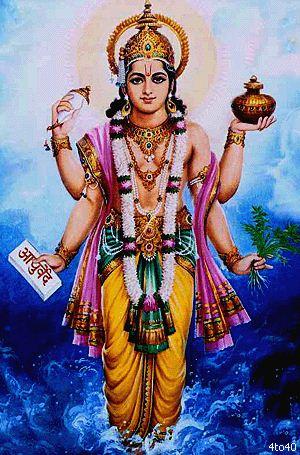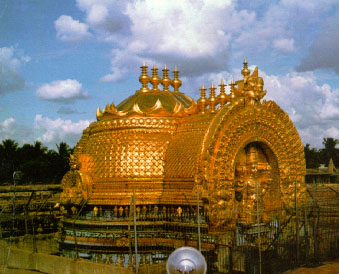Our Reverential salutations to Dhanvantari – God of Ayurveda

‘Om Namo Bhagavate
Maha Sudharshana
Vasudevaya Dhanvantaraye;
Amrutha Kalasa Hasthaaya
Sarva Bhaya Vinasaya
Sarva Roka Nivaranaya
Thri Lokya Pathaye
Thri Lokya Nithaye
Sri Maha Vishnu Swarupa
Sri Dhanvantri Swarupa
Sri Sri Sri
Aoushata Chakra Narayana Swahaâ€
Meaning: We pray to the God, who is known as Sudarshana Vasudev Dhanvantari. He holds the Kalasha full of nectar of immortality. Lord Dhanvantri removes all fears and removes all diseases. He is the well wisher and the preserver of the three worlds. Dhanvantari is like Lord Vishnu, empowered to heal the Jiva souls. We bow to the Lord of Ayurveda.
Dhanvantri Jayanti is dedicated Lord Dhanvantari, the Hindu God of Medicine or Ayurveda. Dhanvantri Jayanti 2011 is on October 24 2011. Dhanvantri is the deity invoked and worshipped by Ayurveda Practitioners. Dhanvanthari Jayanthi is observed during different times by different Hindu communities in different parts of India. Generally speaking, in most States of India it is observed on the day before Diwali.
Dhanvantri is believed to have appeared during the Churning of Ocean or Samdura Mantham by Devas (demi gods) and Asuras (demons). Amidst the numerous auspicious items that appeared during the Churning of Ocean or Samdura Manthan by Devas and Asuras, Dhanvanthari also appeared as elixir or Amruta. Dhanvantri is shown as holding the pot of Amrit in one hand and a leech in another hand. He is believed to have appeared to eradicate diseases threatening living beings. LORD DHANVANTHARI IS ALSO BELIEVED TO BE AN INCARNATION OF LORD VISHNU.
Today (24 October 2011) is the day of Dhanvantari Jayanthi or what is popularly known in different parts of India as Dhan-Trayodashi. Dhanvantari (Dhanwanthari) is the God of Ayurvedic medicine. According to the Hindu tradition, he is an aspect of the avatar of Lord Vishnu. Dhanvantari appears in the Vedas and Puranas as the physician of the Gods (Devas). For centuries, it has been an established practice in Hinduism for people to offer their fervent prayers to Lord Dhanvantari seeking his divine benediction for sound health, free from all aliments and diseases, not only for themselves but also for all, near and dear to them.
Dhanvantari was an early Indian medical practitioner and one of the world’s first surgeons. Based on Vedic traditions, he is regarded as the source and fountainhead of Ayurveda. He perfected a system of herbs and roots – based Ayurvedic cures and natural remedies. He has been credited, among others, with the discovery of the antiseptic properties of turmeric and the preservative properties of salt which he incorporated in his overall regimen of cures. Tradition has it that he was a very skilled surgeon according to the standards of his time and that he was a pioneer of modern medical practices like plastic surgery. According to traditions, he taught surgery methods and procedures to Susrutha, the Father of Ayurvedic Surgery.
As a result of the brilliant achievements of Dhanvantari in the field of Ayurvedic medicine, he was chosen as one of the Nine Gems in the Court of King Vikramaditya. The Nine gems during the reign of Vikramaditya were Dhanvantari, Kshapanaka, Amarasimha, Shanku, Vetal Bhatt, Ghata Karpara, Varahamihira, Vararuchi and Kalidasa the poet. Vikramaditya (102 BCE to 15 CE) was a legendary king of Ujjain, India, famed for his wisdom, valour and magnanimity. During his reign, India ruled most of Asia from the Eastern Arabia to China and North Korea and from Mongolia to Indonesia. He also imparted Vedic rituals to the Middle East and to North Asia. It was during his time that the knowledge of ancient India in disciplines like philosophy, science, astronomy and mathematics made its way to the Arabs which was later transferred to Europe during the period of the Crusades in the fourteenth century, leading to the growth of modern science, mathematics and philosophy in the Age of the European Renaissance in the sixteenth century.
Dhanvantari is depicted as Vishnu with four hands, holding medical herbs in one hand and a pot containing rejuvenating nectar called amrita in another. This depiction can be seen in the picture of Dhanvantari presented at the top of this story.
The Puranas state that Dhanavantari emerged from the ‘Ocean of Milk’ and appeared with the pot of nectar during the story of the Samudra or Sagar manthan whilst the ocean was being churned by the Devas and Asuras, using the Mandara mountain and the serpent Vasuki. The pot of Amrita was snatched by the Asuras. Mohini, another aspect of Lord Vishnu appears and takes the nectar back from the Asuras.
Today is the birthday of Lord Dhanvantari, the God of health, healing and cure. This day is celebrated with great gusto and enthusiasm by the practitioners of Ayurveda in all parts of India every year.
Taxakeshwar temple in Madya Pradesh
There are only a handful of ancient and historic temples dedicated to Lord Dhanvantari in the whole of India. The most important temple in Northern India is at Taxakeshawar or Takhaji ().This is a place of religious and historical importance in Mandsaur district in Madhya Pradesh. It is situated at a distance of 22 km from Bhanpura town on Hinglajgarh road. This is the site of serpent King Taxak, where he is worshiped as Taxakeshawar. In front of the statue of Taxaka is the statue of Dhanvantari. There is also a statue for Dhanvantri, the Indian Aesculapius, at this temple. Asclepius is the god of medicine and healing in ancient Greek religion. Taxakeshawar is known for its natural and scenic beauty. James Tod, the famous author of the Annals of Rajasthan, visited this place in 1821 and was amazed to see its scenic beauty
THE MOST IMPORTANT TEMPLE FOR DHANVANTARI IN SOUTHERN INDIA IS IN THE COURTYARD OF SRI RANGANATHASWAMY TEMPLE AT SRIRANGAM.

Daily worship is offered to Lord Dhanvantari at this spot. In the front of this temple there is an engraved stone believed to date around the 12th Century. The writing on the stone contains the details that Garuda Vahana Bhattar, who was a great Ayurvedic Physician who established the statue of Lord Dhanvantari inside this temple. As a ‘Prasad’ or ‘Teerth’, a decoction of the herbs is given to the visitors at this Dhanvantari temple.
The Dhanvantari traditions in Kerala are indeed glorious and fascinating. In Kerala, the family of ‘Ashta Vaidya’ is famous and traditionally provide Ayurvedic and Siddha treatment to the sick. The forefathers of these Asta vaidyas are still today serving in the same manner as they have been doing for centuries. This family worships Lord Dhanvantari. Some of the members of this family have built temples for Lord Dhanvantari inside their houses while others have built larger temples in his honour. Near Kotakkalat Pulamantol village is a family of Ashta Vaidya. This family has a temple of Lord Dhanvantari. There is another family called Vaidya Madam which is near Vadakkancheri. The Ashta Vaidya families are in the following places:
* Aalyittur
* Cannanore (kannur)
* Kuttancheri
*Taikkad
* Vayaskara
* Vellod
* Chirattaman
* Pulamanthole
* Olassa
Lord Dhanvantari Temple at Nelluvaya near Guruvayur

Besides the larger temples in Kerala listed above, there are smaller temples for Lord Dhanvantari at Nelluvaya (near Guruvayur), Kannur and Calicut.
To conclude in the words of Sri Aurobindo Ghosh: ‘Ancient Indian civilization is not some thing done with, relegated to the past. It continues to live and that is what makes it so utterly fascinating. To study it in depth may not be a must, but to become aware of some of her phenomenal contributions in different fields, to understand what made those achievements possible, to apply some of the secret recipes for brighter futures … all that certainly is. To get under the skin, to soak in the essence, to become one with the spirit of India — there is still much to be learnt …. in what field India has not attempted, achieved, created and in all on a large scale and yet with much attention to completeness of detail? … India of the ages has not spoken her last creative word; she lives and has still something to do for herself and the human peoples.’
Welcome to Haindava Keralam! Register for Free or Login as a privileged HK member to enjoy auto-approval of your comments and to receive periodic updates.
Latest Articles from Dharma Smriti
- In memory of Dr N Gopalakrishnan
- Treading the Middle-Path on Temple Management
- ആദി ശങ്കര ജയന്തി – പ്രഭാഷണം
- അമേരിക്കന് പ്രൊഫസര് ജോണ് ഗ്രൈംസിന് ഭഗവാന് ഗണേശന് കൊടുത്ത ദിവ്യാനുഭവം
- Forgotten Temples Of Malappuram – Part I (Nalambalam of Ramapuram)
- Holy Karkidakam – Ramayana to Echo from Haindava Homes
- Poonthanam’s complete works translated into English
- Pamba Aarati – Dispell the Engulfing Darkness
- Milords! What the judiciary must know before any final verdict on Sabarimala
- Swami Chidanandapuri on Sabarimala

